Page 10 of 361
viii
In 1963, Corvette hit the road with an eye-catching new
look
-- the Sting Ray coupe. An instant success, the
now
-classic Sting Ray featured concealed headlamps
and a unique split rear window. The split window would
only be offered in 1963, making this model among the
most prized Corvettes ever built.
Restyled inside and out for 1968, this 'Vette sported a
lean and hungry shape, creating a sense of motion even
when standing still. And for the first time, Corvette
offered removable roof panels.
Page 81 of 361
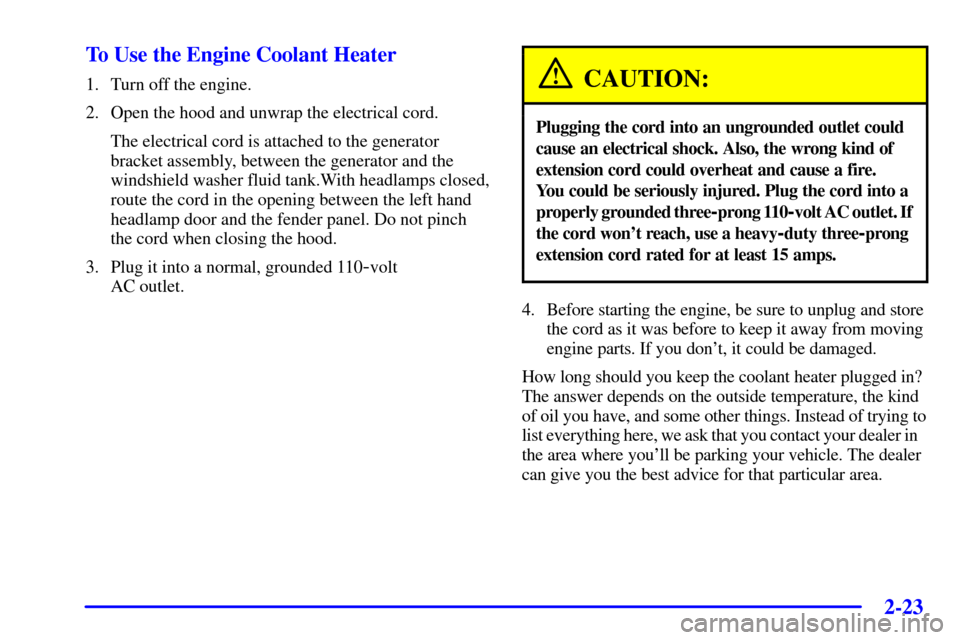
2-23 To Use the Engine Coolant Heater
1. Turn off the engine.
2. Open the hood and unwrap the electrical cord.
The electrical cord is attached to the generator
bracket assembly, between the generator and the
windshield washer fluid tank.With headlamps closed,
route the cord in the opening between the left hand
headlamp door and the fender panel. Do not pinch
the cord when closing the hood.
3. Plug it into a normal, grounded 110
-volt
AC outlet.
CAUTION:
Plugging the cord into an ungrounded outlet could
cause an electrical shock. Also, the wrong kind of
extension cord could overheat and cause a fire.
You could be seriously injured. Plug the cord into a
properly grounded three
-prong 110-volt AC outlet. If
the cord won't reach, use a heavy
-duty three-prong
extension cord rated for at least 15 amps.
4. Before starting the engine, be sure to unplug and store
the cord as it was before to keep it away from moving
engine parts. If you don't, it could be damaged.
How long should you keep the coolant heater plugged in?
The answer depends on the outside temperature, the kind
of oil you have, and some other things. Instead of trying to
list everything here, we ask that you contact your dealer in
the area where you'll be parking your vehicle. The dealer
can give you the best advice for that particular area.
Page 98 of 361
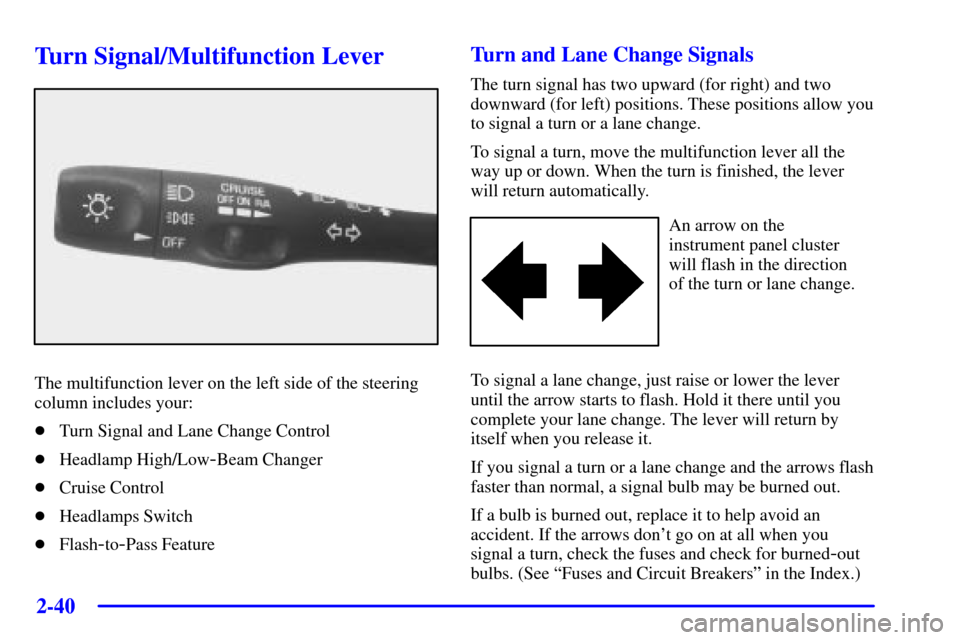
2-40
Turn Signal/Multifunction Lever
The multifunction lever on the left side of the steering
column includes your:
�Turn Signal and Lane Change Control
�Headlamp High/Low
-Beam Changer
�Cruise Control
�Headlamps Switch
�Flash
-to-Pass Feature
Turn and Lane Change Signals
The turn signal has two upward (for right) and two
downward (for left) positions. These positions allow you
to signal a turn or a lane change.
To signal a turn, move the multifunction lever all the
way up or down. When the turn is finished, the lever
will return automatically.
An arrow on the
instrument panel cluster
will flash in the direction
of the turn or lane change.
To signal a lane change, just raise or lower the lever
until the arrow starts to flash. Hold it there until you
complete your lane change. The lever will return by
itself when you release it.
If you signal a turn or a lane change and the arrows flash
faster than normal, a signal bulb may be burned out.
If a bulb is burned out, replace it to help avoid an
accident. If the arrows don't go on at all when you
signal a turn, check the fuses and check for burned
-out
bulbs. (See ªFuses and Circuit Breakersº in the Index.)
Page 99 of 361
2-41
Turn Signal on Chime
A chime will remind you if you leave the turn signal on
for more than 3/4 mile (1.2 km) of driving.
If you need to leave the turn signal on for more than
3/4 mile (1.2 km), turn off the signal and then turn it
back on.
Headlamps
The headlamp band on the turn signal/multifunction
lever controls these lamps:
�Headlamps
�Taillamps
�Parking lamps
�Sidemarker lamps
Turn the band to this symbol to turn on the parking
and other operating lamps except for the headlamps.
Turn the band to this symbol to turn on the
headlamps and other operating lamps.
Turn the band to OFF to turn off the lamps.
To read the odometer with the ignition off, turn on the
parking lamps.Headlamp Doors
The headlamp doors are designed to open when you
turn the headlamps on, and close when you turn the
headlamps and parking lamps off. If you turn the
headlamps on, then turn back to the parking lamps
setting, the headlamp doors will stay open.
Page 100 of 361
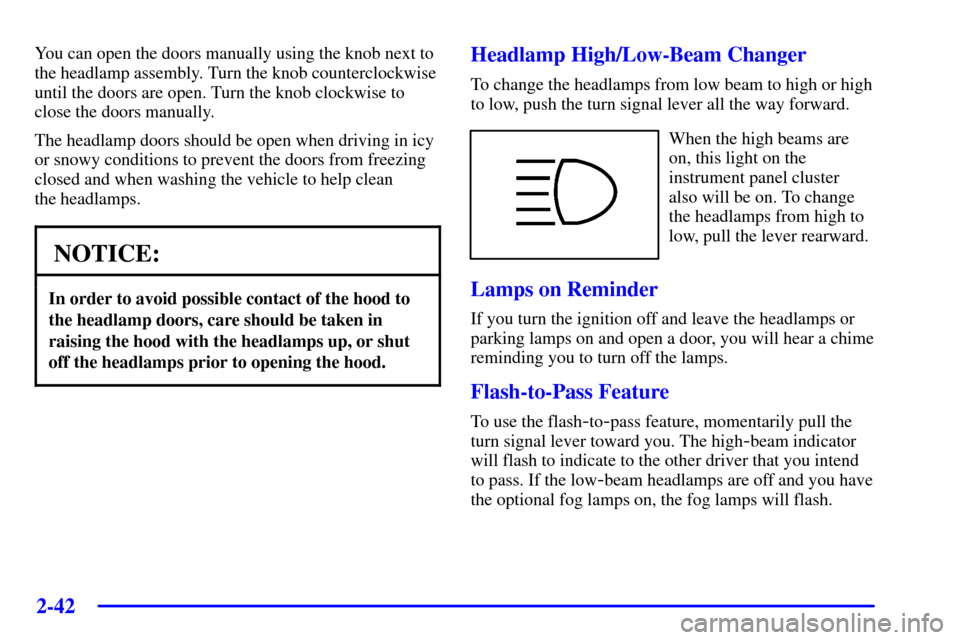
2-42
You can open the doors manually using the knob next to
the headlamp assembly. Turn the knob counterclockwise
until the doors are open. Turn the knob clockwise to
close the doors manually.
The headlamp doors should be open when driving in icy
or snowy conditions to prevent the doors from freezing
closed and when washing the vehicle to help clean
the headlamps.
NOTICE:
In order to avoid possible contact of the hood to
the headlamp doors, care should be taken in
raising the hood with the headlamps up, or shut
off the headlamps prior to opening the hood.
Headlamp High/Low-Beam Changer
To change the headlamps from low beam to high or high
to low, push the turn signal lever all the way forward.
When the high beams are
on, this light on the
instrument panel cluster
also will be on. To change
the headlamps from high to
low, pull the lever rearward.
Lamps on Reminder
If you turn the ignition off and leave the headlamps or
parking lamps on and open a door, you will hear a chime
reminding you to turn off the lamps.
Flash-to-Pass Feature
To use the flash-to-pass feature, momentarily pull the
turn signal lever toward you. The high
-beam indicator
will flash to indicate to the other driver that you intend
to pass. If the low
-beam headlamps are off and you have
the optional fog lamps on, the fog lamps will flash.
Page 105 of 361

2-47
Using Cruise Control on Hills
How well your cruise control will work on hills depends
upon your speed, load and the steepness of the hills.
When going downhill, you may have to brake or shift
to a lower gear to keep your speed down. Of course,
applying the brake takes you out of cruise control.
Many drivers find this to be too much trouble and
don't use cruise control on steep hills.
Ending Cruise Control
There are two ways to turn off the cruise control:
�Step lightly on the brake pedal or push the clutch
pedal, if you have a manual transmission vehicle.
�Move the cruise switch to OFF.
The Driver Information Center (DIC) will display the
message ªCRUISE DISENGAGED.º
Erasing Speed Memory
When you turn off the cruise control or the ignition,
cruise control set speed memory is erased.Exterior Lamps
Daytime Running Lamps
Daytime Running Lamps (DRL) can make it easier for
others to see the front of your vehicle during the day.
DRL can be helpful in many different driving conditions,
but they can be especially helpful in the short periods
after dawn and before sunset.
The DRL system will make the front turn signal lamps
come on when:
�The ignition is on,
�the headlamp switch is off and
�the parking brake is released.
When the DRL are on, only the front turn signal lamps
will be on. The headlamps, taillamps, sidemarker and
other lamps won't be on. Your instrument panel won't
be lit up either.
To idle the vehicle with the DRL off, set the parking
brake while the ignition is in OFF or LOCK. Then start
the vehicle. The DRL, headlamps and parking lamps
will stay off until you release the parking brake.
As with any vehicle, you should turn on the regular
headlamp system when you need it.
Page 106 of 361
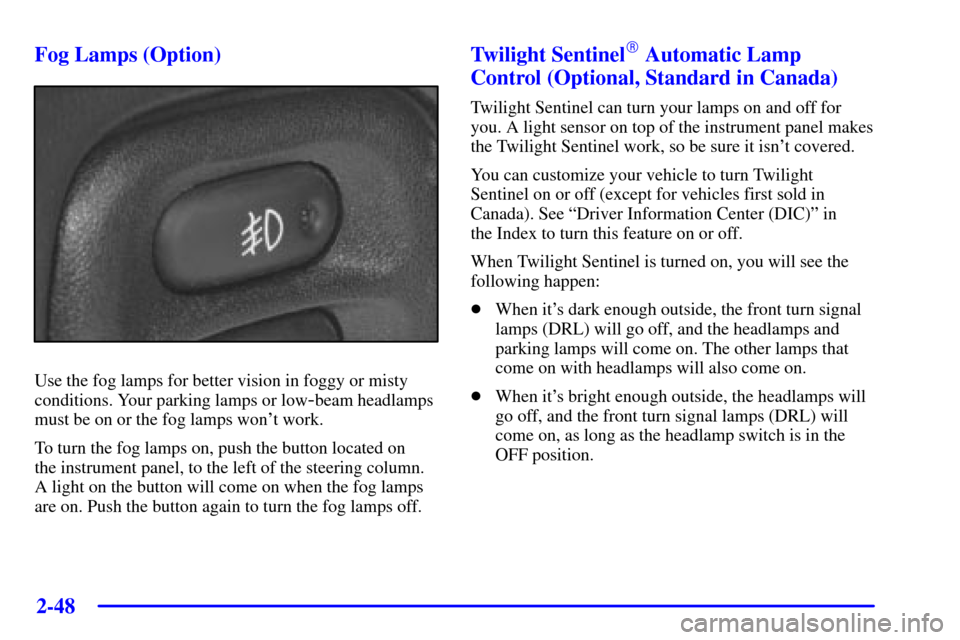
2-48
Fog Lamps (Option)
Use the fog lamps for better vision in foggy or misty
conditions. Your parking lamps or low
-beam headlamps
must be on or the fog lamps won't work.
To turn the fog lamps on, push the button located on
the instrument panel, to the left of the steering column.
A light on the button will come on when the fog lamps
are on. Push the button again to turn the fog lamps off.
Twilight Sentinel� Automatic Lamp
Control (Optional, Standard in Canada)
Twilight Sentinel can turn your lamps on and off for
you. A light sensor on top of the instrument panel makes
the Twilight Sentinel work, so be sure it isn't covered.
You can customize your vehicle to turn Twilight
Sentinel on or off (except for vehicles first sold in
Canada). See ªDriver Information Center (DIC)º in
the Index to turn this feature on or off.
When Twilight Sentinel is turned on, you will see the
following happen:
�When it's dark enough outside, the front turn signal
lamps (DRL) will go off, and the headlamps and
parking lamps will come on. The other lamps that
come on with headlamps will also come on.
�When it's bright enough outside, the headlamps will
go off, and the front turn signal lamps (DRL) will
come on, as long as the headlamp switch is in the
OFF position.
Page 107 of 361
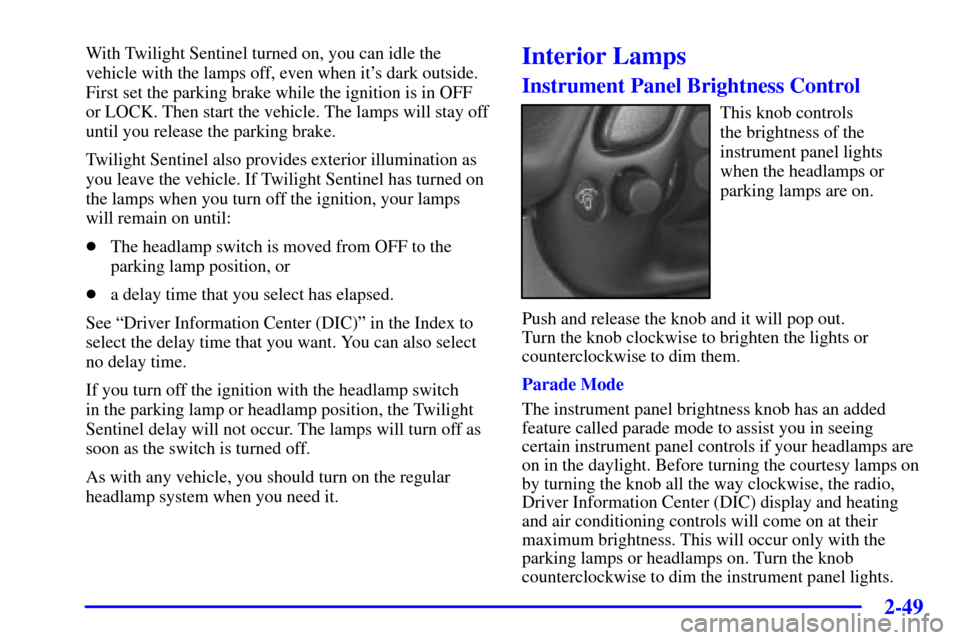
2-49
With Twilight Sentinel turned on, you can idle the
vehicle with the lamps off, even when it's dark outside.
First set the parking brake while the ignition is in OFF
or LOCK. Then start the vehicle. The lamps will stay off
until you release the parking brake.
Twilight Sentinel also provides exterior illumination as
you leave the vehicle. If Twilight Sentinel has turned on
the lamps when you turn off the ignition, your lamps
will remain on until:
�The headlamp switch is moved from OFF to the
parking lamp position, or
�a delay time that you select has elapsed.
See ªDriver Information Center (DIC)º in the Index to
select the delay time that you want. You can also select
no delay time.
If you turn off the ignition with the headlamp switch
in the parking lamp or headlamp position, the Twilight
Sentinel delay will not occur. The lamps will turn off as
soon as the switch is turned off.
As with any vehicle, you should turn on the regular
headlamp system when you need it.Interior Lamps
Instrument Panel Brightness Control
This knob controls
the brightness of the
instrument panel lights
when the headlamps or
parking lamps are on.
Push and release the knob and it will pop out.
Turn the knob clockwise to brighten the lights or
counterclockwise to dim them.
Parade Mode
The instrument panel brightness knob has an added
feature called parade mode to assist you in seeing
certain instrument panel controls if your headlamps are
on in the daylight. Before turning the courtesy lamps on
by turning the knob all the way clockwise, the radio,
Driver Information Center (DIC) display and heating
and air conditioning controls will come on at their
maximum brightness. This will occur only with the
parking lamps or headlamps on. Turn the knob
counterclockwise to dim the instrument panel lights.